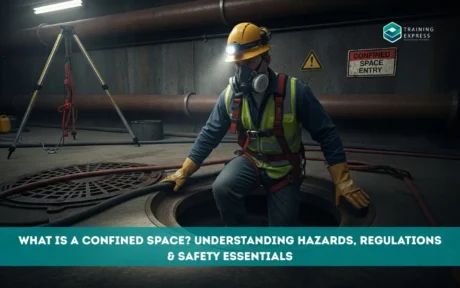
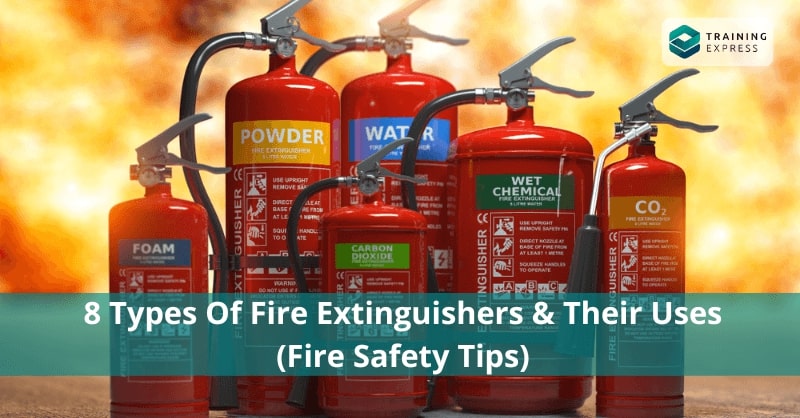
To meet the current regulations, you need to have the right fire extinguisher required for your premises. Due to the various fuels that can cause a fire, you must use different fire extinguishers. Usually, there are eight different types of fire extinguishers. You can’t use a single fire extinguisher for all types of fire. So, it’s important to know more about them to use them effectively and safely.
In this blog, you will learn:
Table of Contents
Why is Fire Safety Important?
Fire safety lowers the risk of injury and building damage that fires can cause. Therefore, developing and implementing fire safety rules in the workplace is not only required by law but is necessary for everyone’s safety, that may be in the building during a fire emergency.
In addition, Fire Safety Training is an essential skill to reduce the risk of injury and building damage that fires can cause.
The fire dangers in your home or business will help determine the type of fire most likely to break out. In most situations, fire hazards are ordinary explosives, flammable liquids like oil or gas, or electrical devices and instruments. In comparison, newer extinguishers are labelled with pictures that show the types of hazards they can be utilised to extinguish.
The first step is to examine what materials are in the area to protect from fire. We can divide these into six fire types concerning different substances.
Six Classes of Fire
There are six classes of fire – Class A, B, C, D, F and Electrical fire. Fires are categorised based on the material that ignites the fire.
1. Class A
Fires generated by solid combustibles. Including wood, fabric and other volatile solids, and paper.
2. Class B
Fires generated by flammable fluids such as turpentine, petrol, or paint, among others.
3. Class C
Fires caused by combustible gases, including butane, hydrogen, and methane.
4. Class D
Fires induced by combustible metals, including aluminium or magnesium and potassium,
5. Class F
Fires are caused by cooking oils, and fats, such as a chip-pan fire.
6. Electrical Fires
Fires involving electrical tools, but the fire class is changed upon reduction of the electrical item.
8 Main Types of Fire Extinguishers and Their Uses
There are 8 types of fire extinguishers. Let’s discuss when and how to use them.
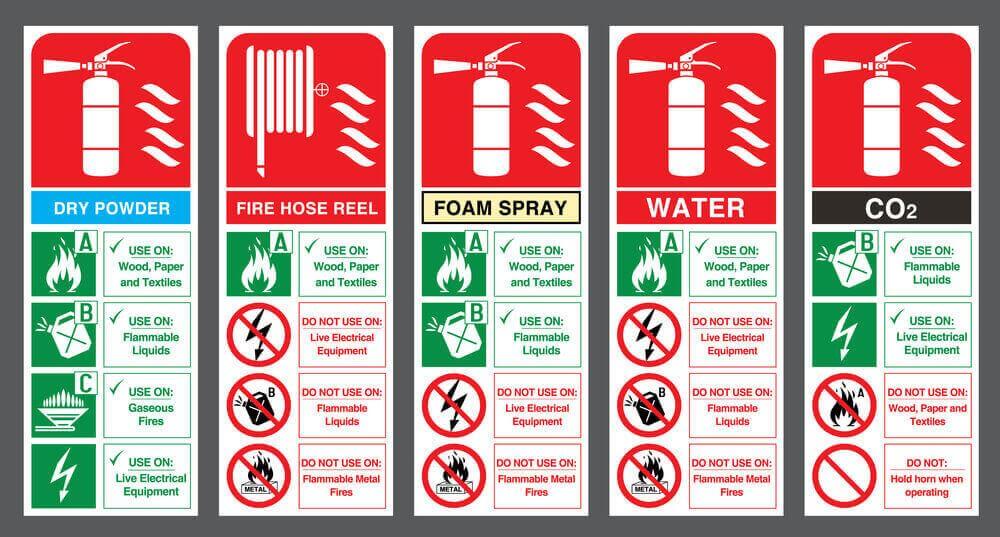
1. Water Extinguishers
Water extinguishers are primarily used for class A fire risk. The water cools the fire and puts it out. It can extinguish spots of fire even deep within the core of fire by penetrating burning textiles.
2. Water Mist Extinguishers
Water mist is electrically non-conductive and is well fit to stop fires in their early stages of development. Besides, water mist fire extinguishers release clean, deionised water through unique spray nozzles in microscopic particle spray that forms a steam or mist curtain that is non-conductive and non-toxic. In addition, the released water droplets are so tiny that they can cool and asphyxiate a fire without damaging the protected spot and contents.
3. Foam Fire Extinguishers
These are the most common types of fire extinguishers used for class B fires. However, these are water-based. So, you can use them for class-A fires.
4. Dry Powder
It includes Standard and Specialised dry powder. It is an ideal or specialist fire extinguisher. The traditional dry powder extinguishers are also known as ABC extinguishers.
Moreover, you can utilise these extinguishers for class A, class B and class C fires. However, these should not be used in confined spaces as the dry Powder in the extinguisher can be easily inhaled. Also, cleaning up the surplus remains is uncomfortable once the fire is over. These can also be used for fire, regarding electrical tools.
5. Carbon Dioxide (CO2) Extinguishers
Use CO2 extinguishers for electrical fire risks; they are usually the primary fire extinguisher type in computer server rooms.
6. Wet Chemical Fire Extinguishers
Wet chemical extinguishers are developed for Class F fires involving cooking oils and fats.
7. Dry Chemical Extinguishers
Wet chemical fire extinguisher terminates the chemical reaction of a fire. It is the most used of all fire extinguishers because of its usability across class A, B and C fires.
8. Clean Agent
A clean agent is any fire-extinguishing agent that is electrically non-conductive, volatile, or gaseous and does not leave a residue upon evaporation. Clean agent fire suppression methods use an inert chemical or gas stored in a container and discharged when a fire is detected.
Fire Extinguisher Colour Codes
Firstly, the water fire extinguisher has a red label. It has class A rating. It is appropriate for fighting fires affecting solid combustibles such as paper, textiles, and wood.
Secondly, the foam fire extinguisher has a cream label and is greatly useful on class A and class B fires (the foaming agent helps to stop re-ignition).
Thirdly, the CO2 fire extinguisher has a black label. It can extinguish flammable fluid or liquid fires. Therefore, have a class B fire rating.
Fourthly, the ABC powder fire extinguisher has a blue label. Besides, It is adaptable, and you can use it on class A, class B, class C and electrical fires.
And, De-ionised water mist fire extinguishers marked with white label. In addition, They are highly useful in classes A, B, and C and burning electrical equipment.
Finally, the Wet chemical fire extinguishers have a yellow label. You can use it on fires involving flammable cooking oil and fat.
In brief-
The five fire extinguisher colours are
- Red – Water (Spray and Mist).
- Cream – Foam, Bubbles.
- Blue – Dry Powder.
- Black – Carbon Dioxide (CO2).
- Yellow – Wet Chemical.
If you want to become a Fire Extinguisher Technician, you might find this course and certification helpful.
Fire Extinguishers for Electrical Fires
You must put out electrical fires with non-conductive substances. If someone tries to put out an electrical fire with something like water, there is a high chance of electrocution, as water is conductive. This is why you need to use class C fire extinguishers.
Potassium chloride, potassium bicarbonate, and mono ammonium phosphate can be found in these types of fire extinguishers. Another option would be a Carbon Dioxide extinguisher. CO2 is ideal for repressing fires as it takes the fire’s oxygen away and reduces its heat since the CO2 is cold when deported from the extinguisher.
Overall, the most helpful way to prevent these accidents is to have a professional conduct electrical work when required rather than doing it alone without the proper knowledge. Other than that, regular checks on objects requiring electricity to function and annual reviews on the fire extinguishers themselves are crucial.
However, it is always helpful to keep a class A fire extinguisher on hand, depending on what other flammable components are around, just in case the fire spreads to something else.
How to Use a Fire Extinguisher?
Fire safety specialists advise you to understand how to use an extinguisher before an emergency occurs. Check with your fire branch to see if they offer any training.
In addition, keep extinguishers where you can see them and get them smoothly around the room’s door. That way, you can resist the fire with your back to the door and quickly escape if the flames get out of control.
Besides, the Fire Extinguisher Technician course can teach you everything on the topic thoroughly from scratch.
P.A.S.S
When using a fire extinguisher, remember to always P.A.S.S. (pull, aim, squeeze, sweep)
- Pull the extinguisher’s security pin.
- Aim the chemical at the head of the flames rather than at the flames themselves, standing about 6 feet from the fire.
- Squeeze the trigger and maintain it, keeping the extinguisher upright.
Sweep the origin of the fire until the extinguisher runs dry.
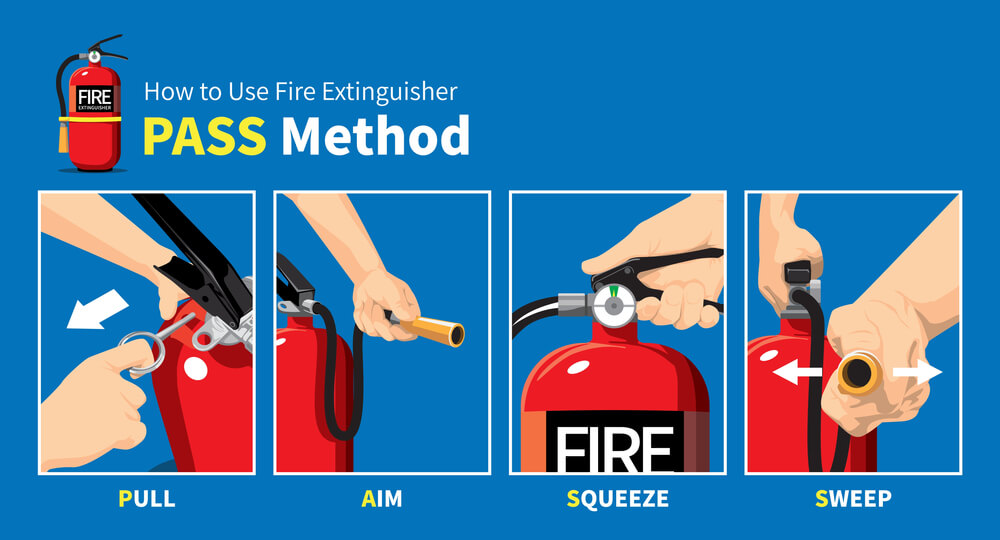
How to Use Other Fire Safety Equipment?
There are other fire safety equipment that can help put out fires. These equipments are
- Fire Blankets, Hoses and Buckets
- Automatic Fire Extinguishers
- Vehicle Fire Extinguishers
- Fire Extinguisher Covers
Fire Blankets, Hoses and Buckets
Fire blankets can help with kitchen or house fires like deep fat fryers. The first thing you can do (if possible) is to turn off the heat source and pull the blanket out so that it is sufficient to cover the whole flame. Leave well alone if the fire is more significant than the blanket.
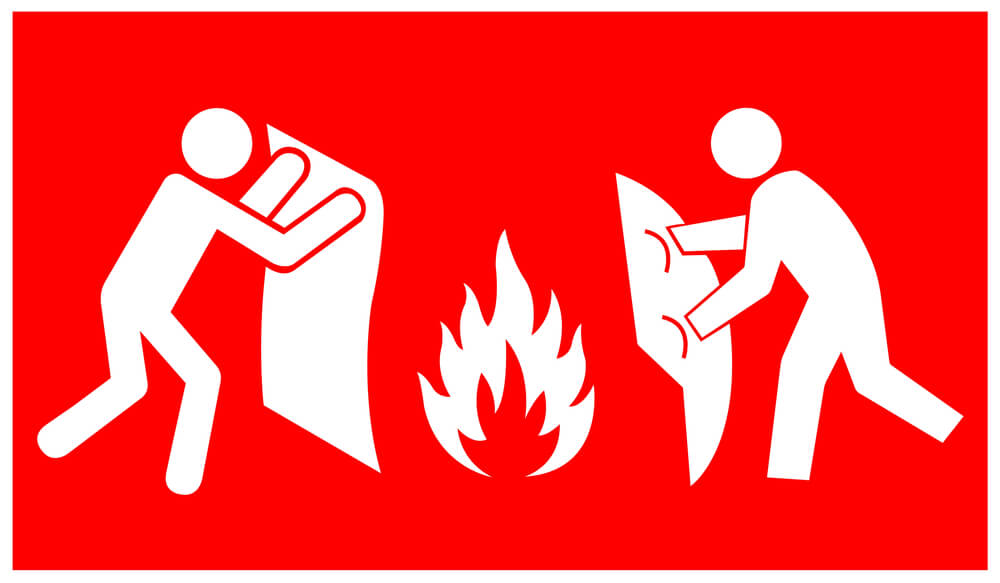
Professionals use fire hoses to bring water to stop a fire from spreading and extinguish the flames. ‘Attack Fire Hoses’ get water from a fire pump to a fire. ‘Supply Line Fire Hoses’ bring a large amount of water from a pressurised source to a fire pump.
You can use ‘Booster Fire Hoses’ to fight small fires. ‘Pin Rack and Reel’ fire hoses are generally installed in buildings to give residents fire hoses for initial fire reaction in an emergency. ‘Wildland’ fire hoses are invented for firefighting applications where the hoses must be carried long distances to reach a fire.
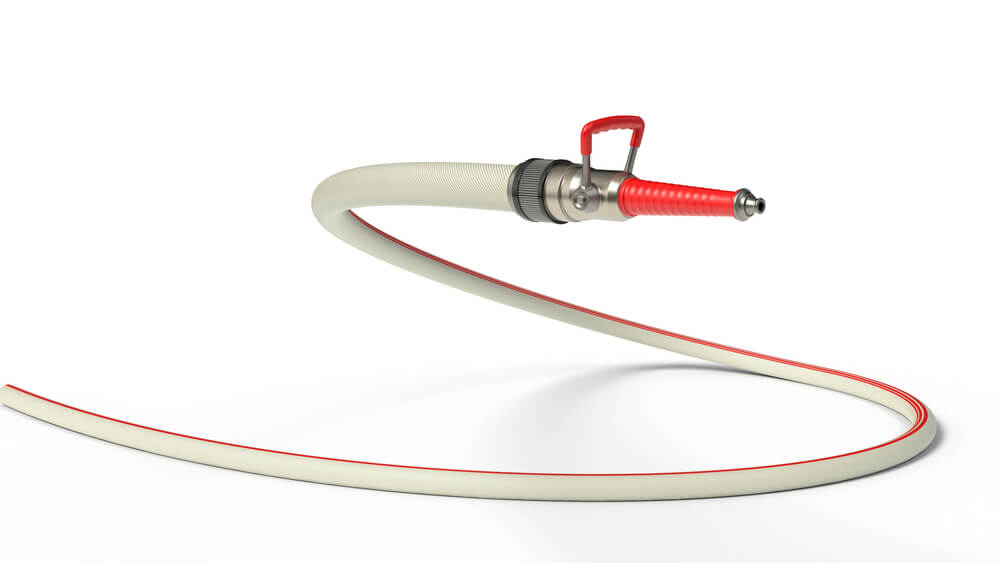
Firefighters load A Fire Bucket with sand or water to extinguish fires. They often use sand where there is a risk of spilt flammable or volatile liquid, which might ignite and outspread by floating across the ground. In addition, the sand acts as a hindrance to the flowing fluid.
You can use water-filled fire buckets where a water extinguisher might not be convenient, or a supplement is prudent.
Both metal and plastic fire buckets are useable and available:
- Usually filled with sand to prevent flammable liquids from leaking or spreading.
- Appropriate for garage forecourts and car parks.
- Wall bracket available separately.
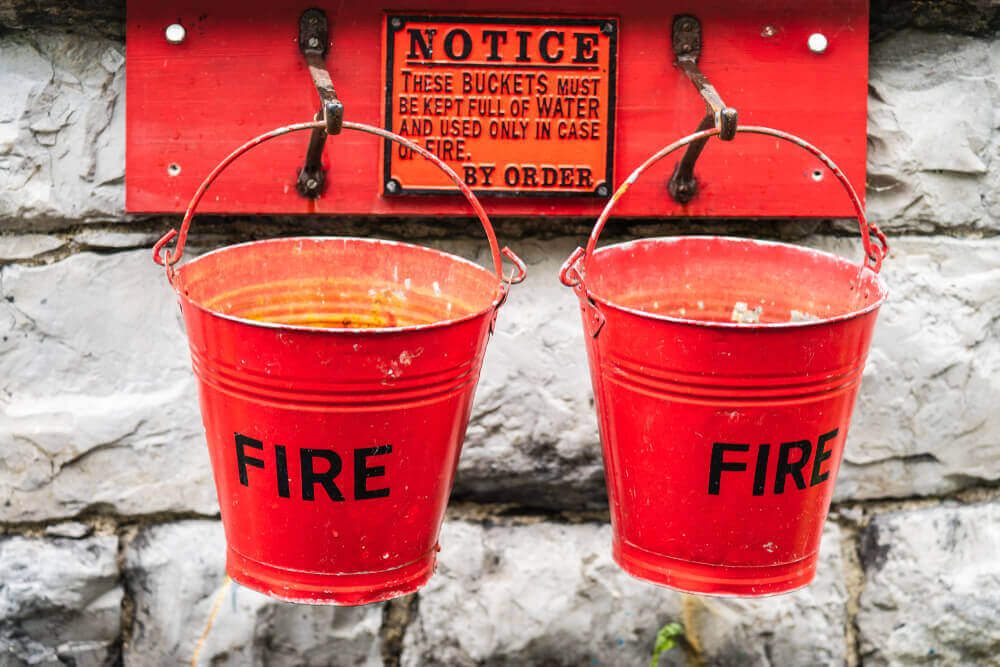
Automatic Fire Extinguishers
The automatic fire extinguishers are activated by heat levels commonly associated with fire. So, they are majorly installed in unsupervised areas. Hence, an automatic operation is the only resolution for round-the-clock defence against any fire.
Benefits include easy recharging and lack of constant monitoring, and reduction of the need for manual operation in unmanned zones.
In addition, these extinguishers are designed to take automatic action when they detect heat. On the downside, their placement is crucial since they could be set off incorrectly when the temperature gets the trigger level.
Vehicle Fire Extinguishers
Motor vehicle fires are not unusual due to the sophistication of the vehicle’s electrical and automated systems, not to say the possibility for oil or fuel to ignite. Some familiar reasons for fires include electrical problems, leaks in the fuel tank, mechanical defeats with the car’s battery, engine overheating etc.
Typically, including dry powder for tackling Class A, B and C fires, their size should be determined according to the size and kind of vehicle. They can be purchased for around £11 for a 600g model to £70 for 12 kg for larger vehicles. Their use is recommended but is not a legal condition for regular cars.
Fire Extinguisher Covers
Different types of fire extinguisher covers are used to protect fire extinguishers from dirt and dust. Depending on quality and size, they cost between £8-£25. In addition, They save extinguishers in extreme environments. Moreover, hose reel covers are also available.
Automatic Fire Extinguishers
The automatic fire extinguishers are activated by heat levels commonly associated with fire. So, they are majorly installed in unsupervised areas. Hence, an automatic operation is the only resolution for round-the-clock defence against any fire.
Benefits include easy recharging and lack of constant monitoring, and reduction of the need for manual operation in unmanned zones.
In addition, these extinguishers are designed to take automatic action when they detect heat. On the downside, their placement is crucial since they could be set off incorrectly when the temperature gets the trigger level.
Vehicle Fire Extinguishers
Motor vehicle fires are not unusual due to the sophistication of the vehicle’s electrical and automated systems, not to say the possibility for oil or fuel to ignite. Some familiar reasons for fires include electrical problems, leaks in the fuel tank, mechanical defeats with the car’s battery, engine overheating etc.
Typically, including dry powder for tackling Class A, B and C fires, their size should be determined according to the size and kind of vehicle. They can be purchased for around £11 for a 600g model to £70 for 12 kg for larger vehicles. Their use is recommended but is not a legal condition for regular cars.
Fire Extinguisher Covers
Different types of fire extinguisher covers are used to protect fire extinguishers from dirt and dust. Depending on quality and size, they cost between £8-£25. In addition, They save extinguishers in extreme environments. Moreover, hose reel covers are also available.
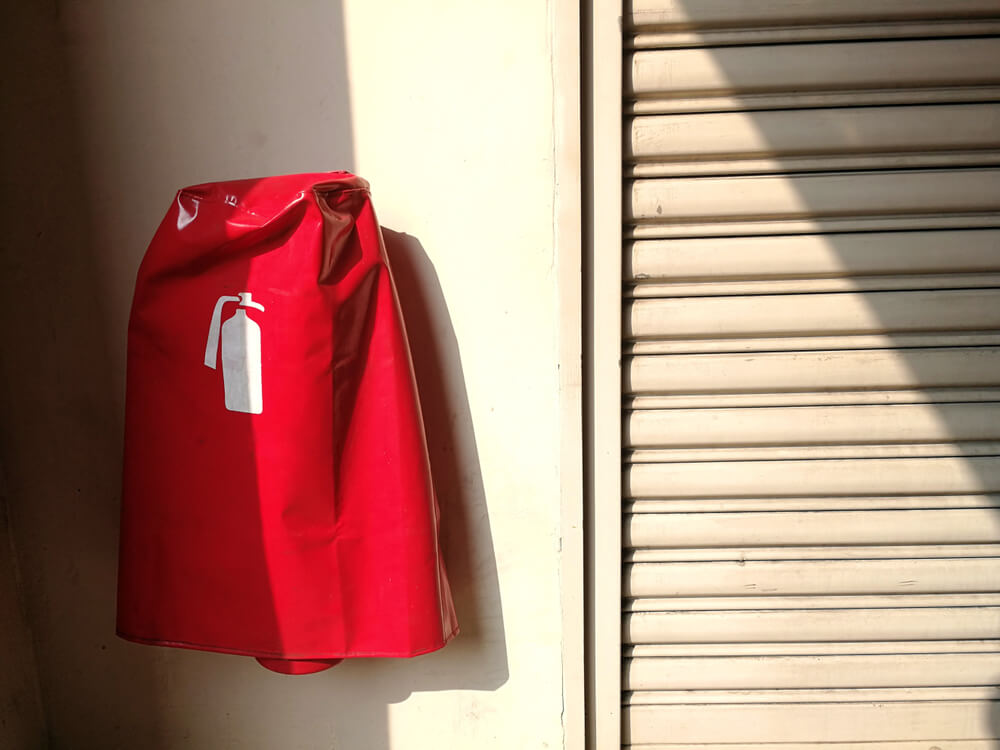
How to Choose the Right Type and Class of Fire Extinguisher for the Appropriate Scenario, Including Colour Codes, Fire Classes and Uses?
Fire extinguishers can be effective only when you select the correct one, install them in the most appropriate locations, and learn how to use them properly. No matter what type of fire extinguisher you choose, knowing the correct way to use it is the most critical factor in its effectiveness.
Therefore, be sure to prepare yourself and your employees to put out a fire using a fire extinguisher correctly. In addition, choosing the suitable fire extinguisher for the relevant fire types could be the saviour in an emergency.
You can not use a single extinguisher to tackle each type of fire. So here’s a helpful direction on selecting the right kind and class of fire extinguisher for the appropriate scenario, fire classes and uses and including colour codes.
How to Select a Suitable Fire Extinguisher?
Experts categorise types of fire extinguishers based on the type of fire they can put out. For example, older fire extinguishers have coloured geometrically shaped tags that indicate their category. Let’s see how to select a particular fire extinguisher.
- What materials could fuel a fire?
- How much of that material is available?
- Who will use the extinguisher?
- The capacity of the extinguisher
- Whether chemicals at the location could react with the extinguishing agent.
Purchasing Your Fire Extinguisher
The stages of purchasing a fire extinguisher are easy, and being well-informed renders the task even more effortless.
Firstly, select which type of fire extinguisher you need.
Secondly, consider other characteristics of fire extinguishers.
Thirdly, purchase a fire extinguisher online or from a store nearby.
How Much is a Fire Extinguisher?
The price may vary depending on the fire extinguisher’s quality and features. If you use a local service company, you should wish to pay a visit charge of around £15-30 + vat and a price per extinguisher of approximately £20-£50. In addition, parts are available at £2-£3 per extinguisher.
Do Fire Extinguishers Expire?
It’s a little hard to tell when your extinguisher will expire. That’s because, unlike regular products, the manufacturers do not write the expiration date on the extinguisher’s body. As a result, there are general rules regarding how long you should use your extinguisher. The length of use, however, relies on the fire extinguisher.
Generally speaking, extinguishers with dry chemicals have a service period of 6 to 12 years. Others, like pressurised carbon dioxide and wet chemical types, have a service period of 5 years.
In addition, your fire extinguisher does not stop functioning entirely after these periods. But for safety causes, you should take the extinguisher for hydrostatic trials. That way, you can confirm the goodness of the shell of the extinguisher.
Fire Extinguisher Safety Tips and Best Practices
First, use transportable types of fire extinguishers if the fire is within a small area, such as a wastebasket; everyone has escaped the building; the fire department has been called, and the room is not filled with smoke.
Second, always remember the acronym PASS.
- Pull the pin first. Then hold and keep the extinguisher with the nozzle pointing away from you, and then release the locking key.
- Aim low. Hold the extinguisher at the bottom of the fire.
- Squeeze the lever gradually and evenly.
Sweep the nozzle from side to side.
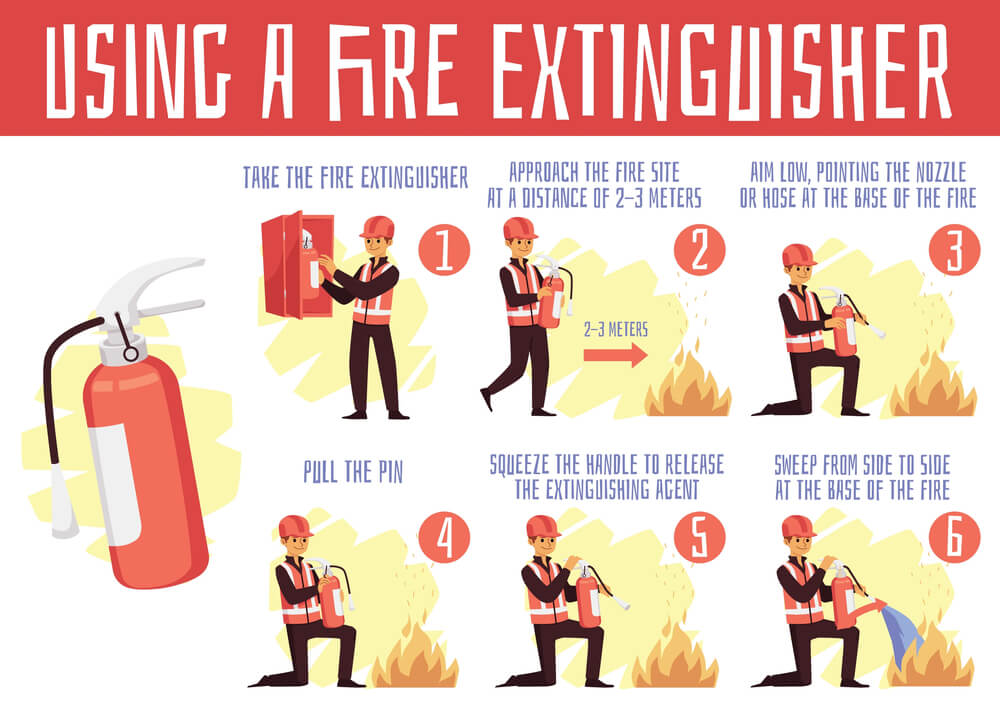
For the home, select a multipurpose extinguisher (which can be operated on all types of home fires) that is sufficient to put out a small fire.
In addition, read the fire extinguisher instructions and become familiar with its parts and function before a fire breaks out.
Besides, install fire extinguishers near an exit and keep your back to a clear door when you use the instrument, so you can quickly exit if the fire cannot be restrained. Finally, If the room fills with smoke, leave immediately.
Proper Fire Extinguisher Maintenance
Maintenance procedures must include the instructions detailed in the manufacturer’s service manual and a thorough review of the essential parts of the fire extinguisher, including the following:
- Mechanical features of all fire extinguishers.
- Extinguishing agent.
- Expelling means.
- Physical condition.
To do this, do an external investigation with help from a third party. An internal examination can also be needed as part of your maintenance. Your fire extinguisher service manual details how to do an internal investigation.
Maintenance Schedule
Fire extinguishers should have an external maintenance examination executed every year. In addition, fire extinguishers need to have an internal test conducted anywhere from 1-6 year gaps based on the type of extinguisher.
For example, a dry chemical, CO2 or stored pressure fire extinguisher should have an internal examination every six years.
Inspection Process
Executing an inspection is the most straightforward thing to confirm your extinguisher is reliable and effective in an emergency. At a minimum, the assessment needs to consist of the following steps:
- Firstly, make sure it is located in its assigned place.
- Secondly, make sure the extinguisher is visible or there is signage showing where the extinguisher is located.
- Thirdly, make sure you can easily access the extinguisher.
- Fourthly, ensure the pressure meter is in operable coverage or position.
- In addition, for wheeled extinguishers, make sure the condition of wheels, carriage, hose, tires and nozzle is in good condition.
- Finally, for non-rechargeable extinguishers, use the push-to-test pressure indicators.
How to Store Fire Extinguishers?
Many people don’t know the best practices for storing modern extinguishers. They can keep an extinguisher horizontally (the contents are under pressure, and the storage angle will not push the system to leak).
Moreover, appropriate fire extinguisher storage includes using the correct mounting brackets to keep the extinguisher within comfortable access. Additionally, horizontal storage isn’t optimal for employee access in a crisis, so experts don’t suggest this.
Most modern extinguishers can perform appropriately at a wide temperature range. For example, certain extinguishers should be kept in temperatures ranging from -40 degrees F to 120 degrees Fahrenheit to avoid severe damage to the hose, valve, or tank.
Most workplaces shouldn’t have a problem keeping their extinguishers within that temperature range, but in extreme cases, it could happen! In addition, fire extinguishers kept at too low a temperature could reach a cracked valve or hose, so avoid allowing your extinguishers to freeze.
Summary
Fire extinguishers may all look the same and similar, but you must use different types of fire extinguishers to extinguish different classes of fires. Moreover, the correct fire extinguisher for your needs is critical to protect lives and assets and will help you safeguard life if a fire breaks out.
Law suggests planning and implementing fire safety protocols in the workplace as it is important to everyone’s safety in the building during a fire emergency.
For career opportunities and skill development, you can check out these courses- Fire Safety Training and Fire Extinguisher Technician.
FAQ
What are the Five Types of Fire Extinguishers?
There are five major fire extinguisher classes –
Water, Foam, Dry Powder, CO2 and Wet Chemicals.
Which Extinguisher is Used for Each Class of Fire?
Class A fires involve tangible or real materials such as paper, textiles, and wood. Class B – fires involve volatile liquids such as petrol, diesel or oils. Class C – fires involving gases. Class D – fires involving metals. You can use wet chemical extinguishers for Class F- fires involving cooking oils and fats.
Which Fire Extinguisher is Used for All?
You can’t use a single fire extinguisher for all classes of fire. The eight types of fire extinguishers include standard dry powder, water mist, foam, water spray, dry powder, wet chemical and carbon dioxide. You need to use different fire extinguishers based on the type of fire.
How Long is the Shelf Life of a Fire Extinguisher?
Although fire extinguishers don’t have an actual “expiration date,” they generally have a 10-12 year life expectancy. Therefore, you should replace disposable (non-rechargeable) fire extinguishers every ten years.
- Available Courses
- Law10
- IT & Software225
- Design28
- Training6
- Accounting & Finance Primary48
- Teaching & Academics Primary36
- Teaching22
- Quality Licence Scheme Endorsed166
- Healthcare169
- Animal care10
- Job Ready Programme52
- Charity & Non-Profit Courses28
- HR & Leadership4
- Administration & Office Skills2
- Mandatory Training36
- Regulated Courses4
- Health and Safety522
- Marketing38
- Career Bundles201
- Construction62
- Electronics31
- Hospitality28
- Health and Social Care289
- Child Psychology40
- Management423
- Business Skills292
- First Aid73
- Employability286
- Safeguarding79
- Food Hygiene116
- Personal Development1600

 Food Hygiene
Food Hygiene Health & Safety
Health & Safety Safeguarding
Safeguarding First Aid
First Aid Business Skills
Business Skills Personal Development
Personal Development



